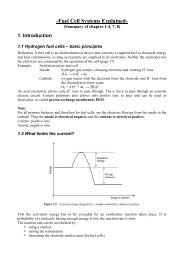Chapter 8. ORGANIC SOLAR CELLS - from and for SET students
Chapter 8. ORGANIC SOLAR CELLS - from and for SET students
Chapter 8. ORGANIC SOLAR CELLS - from and for SET students
Create successful ePaper yourself
Turn your PDF publications into a flip-book with our unique Google optimized e-Paper software.
1.1. REFRACTION AND DISPERSION CHAPTER 1. LIGHT MANAGEMENT<br />
Figure 1.4: The Law of Snell<br />
When light moves <strong>from</strong> a medium of a given refractive index n1 into a second medium with refractive index n2,<br />
both reflection <strong>and</strong> refraction of the light may occur.<br />
Since it has an electromagnetic <strong>and</strong> a magnetic vector that changes in time, we need to take a closer look.<br />
We can have two cases:<br />
� P-polarization: Electric field parallel to plane of Incident (p=parallel)<br />
� S-polarization: Electric field perpendicular to plane of incident (s=senkrecht)<br />
These two cases can also be seen in figure 1.5.<br />
Figure 1.5: P-Polarization <strong>and</strong> S-Polarization<br />
For the P- <strong>and</strong> S-Polarization different equations <strong>for</strong> transmission <strong>and</strong> reflectance hold.<br />
For the reflectance is given by:<br />
<strong>and</strong> the transmission by:<br />
R = ( n1 − n2<br />
)<br />
n1 + n2<br />
2<br />
T = ( 4n1n2<br />
2<br />
) (1.5)<br />
n1 + n2<br />
At one particular angle <strong>for</strong> a given n1 <strong>and</strong> n2, the value of Rp goes to zero <strong>and</strong> a p-polarised incident ray<br />
is purely refracted. This angle is known as Brewster’s angle, <strong>and</strong> is around 56 <strong>for</strong> a glass medium in air or<br />
vacuum. Note that this statement is only true when the refractive indices of both materials are real numbers,<br />
as is the case <strong>for</strong> materials like air <strong>and</strong> glass. For materials that absorb light, like metals <strong>and</strong> semiconductors,<br />
n is complex, <strong>and</strong> Rp does not generally go to zero. When moving <strong>from</strong> a denser medium into a less dense one<br />
(i.e., n1 ¿ n2), above an incidence angle known as the critical angle, all light is reflected <strong>and</strong> Rs = Rp = 1. This<br />
phenomenon is known as total internal reflection. The critical angle is approximately 41 <strong>for</strong> glass in air. This<br />
can also be seen in figure 1.6<br />
The Brewster angle can be calculated <strong>from</strong>:<br />
θBrewster = arctan( n2<br />
The critical angle can be determined <strong>from</strong> Snells law using:<br />
5<br />
n1<br />
(1.4)<br />
(1.6)






